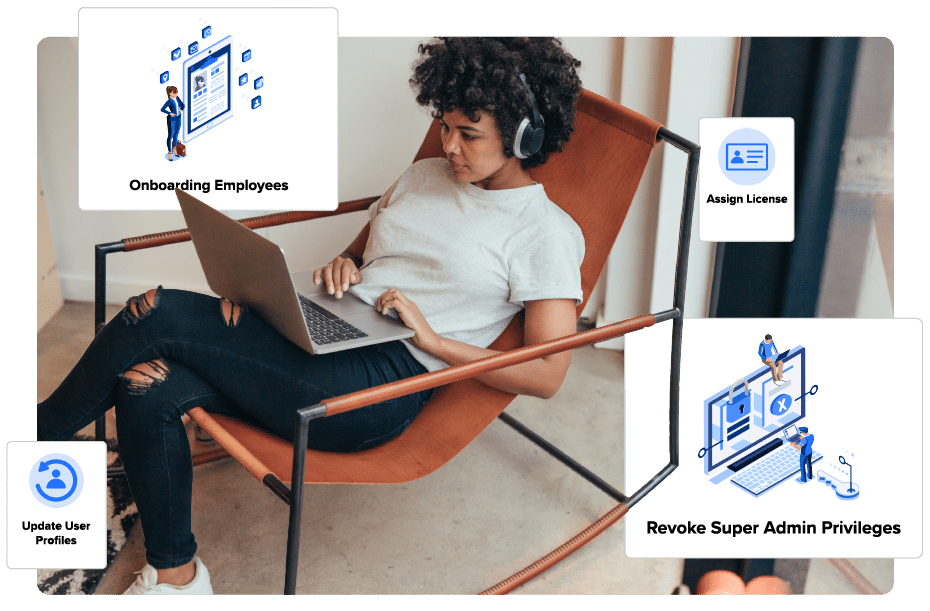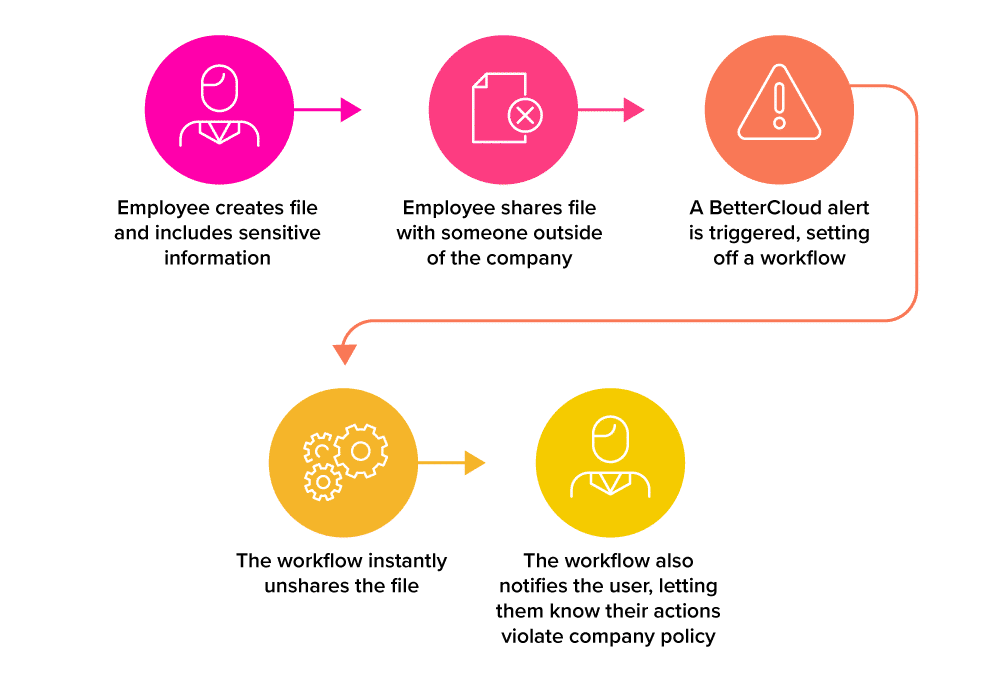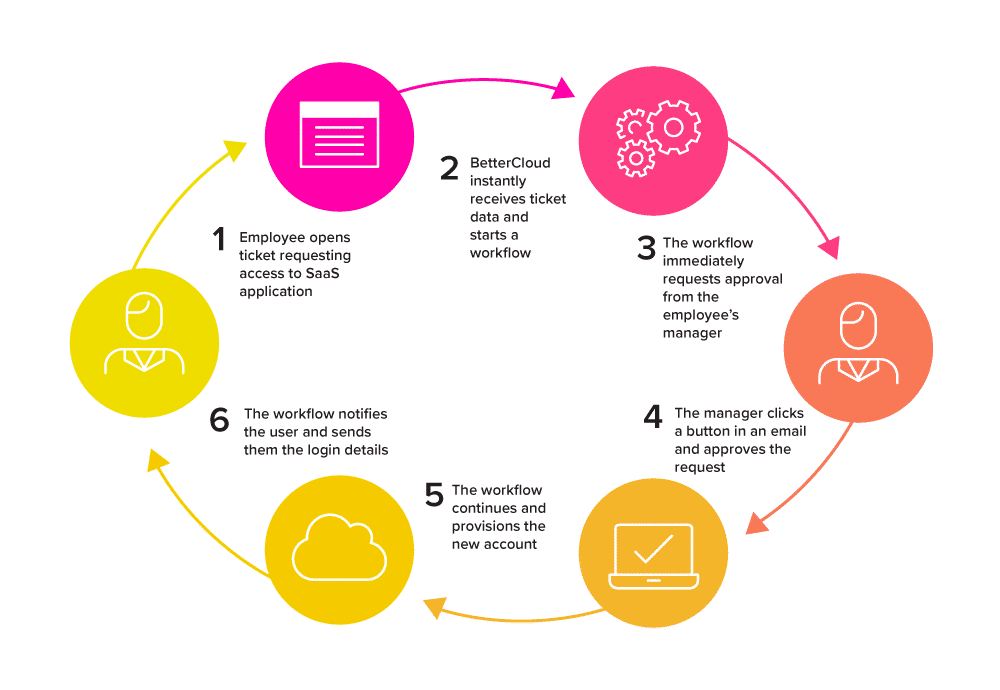What is no-code IT workflow automation for SaaS management?
Now that most organizations operate on SaaS, it’s easy to see why every enterprise must use a SaaS management platform (SMP). After all, they’re necessary for efficiently managing SaaS apps, users, security, spend, and budgets. Yet, there’s another SMP aspect that requires understanding and it’s why every organization needs no-code IT workflow automation for SaaS management.
Dive into no-code IT workflow automation, explore its benefits for SaaS management, and learn why BetterCloud is the most comprehensive platform for automating your SaaS environment.

What is no-code IT workflow automation for automated SaaS management?
Fundamentally understanding the role of no-code IT workflow automation starts with defining IT automation. Increasingly a cornerstone of a modern IT department, its primary goal is to replace time-consuming manual tasks by developing and operating automated processes. IT accomplishes this by using software-created workflows.
To breakdown what makes up a workflow, it has:
- Triggers that are conditions when met, automatically launch an action, or actions
- Actions that are the tasks that should happen once triggered
- Integrations that connect two applications for both data flows and actions
If you have a development team that writes code, they use a toolset to write code to automate IT processes.
Without coding or development skills, SaaS management teams must rely on a low or no-code platform. In these kinds of software platforms, triggers and actions that make up a workflow are small pieces of code that are pre-packaged into reusable components.
Low-code platforms require technical skills
As the name might imply, low-code IT automation tools still require some development skills. They generally use a drag-and-drop interface, which still makes solution development easier and faster than traditional development toolsets. However, depending on the tool, specialized skills are required and there’s a long learning curve.
Those with technical expertise and experience use pre-built code and processes in a low-code platform to build solutions. Because they usually have limited actions, triggers, or integrations, low-code platform users must write code to build improved or customized solutions.
No-code tools use drag-and drop visual development
Instead of manually writing code for triggers and actions using conditional logic, no-code tools use a drag-and-drop, point-and-click workflow builder. Since a user creates workflows visually, non-technical people with no background in programming or coding can build workflows.
There can be a learning curve, but unlike low-code tools, the best no-code workflow platforms are relatively easy to learn. This way, anyone on the SaaS management team can create and operate workflows quickly.
No-code tools are relatively easy to launch and don’t need coding to operate. To build a workflow, an IT team member simply selects from a library of reusable standard triggers and common actions, as well as pre-built integrations to easily connect commonly used SaaS apps.
The most complete no-code platforms also have a large range of customizable workflow templates. These are adaptable, predefined automation recipes that provide starting points for additional workflow customization.
Large libraries of pre-packaged, reusable components lead to faster workflow building
Of course, some no-code platforms have larger libraries or more templates than others. And certainly, some platforms will have more pre-packaged components for your use cases and others may have less. After all, user lifecycle management involves more than app provisioning in some platforms than others.
As you continue to define your company’s no-code IT workflow platform requirements, it’s vital to examine the pre-packaged SaaS management components that are already available in each solution and those on vendor roadmaps.
Faster IT process automation speeds time-to-benefits
Nonetheless, all pre-packaged, reusable workflow components - together with a drag-and-drop visual environment – enable faster process orchestration in fewer steps than low-code or traditional code-writing.
The quicker an organization gets IT and SaaS management processes automated, the faster IT and the whole organization benefit, and the better the return on investment.
Benefits of no-code IT workflow automation for SaaS management
No-code workflow platforms empower IT teams to innovate and streamline routine SaaS management processes -- creating gains that reverberate throughout the company. Here are some benefits:
Agility and flexibility:
Without traditionally coding workflows, IT can develop and refine no-code workflows as needed. In addition, they can respond faster to required workflow changes to maximize SaaS management efficiency.
Improve IT and developer productivity:
No-code IT workflow automation frees up developer time that would be spent on IT operations to do other things. For IT, it spares them from time-robbing, mundane, routine tasks to spend time on more strategic IT projects and grow productivity.
Save money:
No-code IT workflow automation is so easy that any IT staff member can create and optimize workflows. Without using expensive developers for SaaS management, the savings add up.
Better decision-making:
Analytics and reporting from no-code platforms provide valuable insights on workflow execution and performance that enable continual IT process optimization.
Improved employee experience:
No-code IT workflow automation reduces the amount of human labor required in providing fast SaaS management from IT. With workflows that onboard employees more quickly or resolve help desk tickets in an instant, employees get faster resolution. In turn, satisfaction and productivity improve for both IT and employees.
Scalability:
As the organization grows, no-code IT workflow automation helps IT scale operations. By automating SaaS management tasks and orchestrating complex processes, IT can support an increasing headcount or support mergers without adding IT staff.
Reduced error and higher consistency and security:
No-code IT workflow automation provides a consistent approach to automating IT processes and eliminates human error and improves security.
No tool is magic, and learning a no-code workflow platform for SaaS management takes time. However, automating just a few processes makes them worth their cost.
With any automation platform, the more you use it and the more you automate, gains compound over time. Automate your all your SaaS management process and return on investment goes sky high.
No-code automation for SaaS management: When and how to use it
No-code automation is valuable to automate many processes across IT. In this section we’ll review some common SaaS management use cases that all organizations should aim to automate now.
Sensitive data protection: Either maliciously or inadvertently, an employee can share sensitive data outside the company. Build a workflow to protect data with the following steps once automated alert is triggered:
- Revoke sharing permission for the file immediately
- Send email notification to manager of inappropriate sharing
- Send email notification informing user that sensitive sharingviolated company policy and that there are security risks associated with it

SaaS stack protection against unsanctioned apps: Create a workflow to automatically remediate shadow IT usage that is triggered by an employee uses work credentials granting OAuth access.
- Send notification to IT
- Revoke access immediately to the app that logs out the user.
- Send email notification to the user that it violated company policy, and the security risks unsanctioned apps can create
Onboarding: use no-code automation for zero touch onboarding workflows that start with hardware and end with employee access. Build a workflow to:
- Automate patching, configuration, and control of computers
- Link local computer user account to an identity provider, so users seamlessly log into computers using existing corporate credentials and secure them with MFA, and to drop-ship computers directly to employees
- Provision access to all apps, groups, drives, and calendars, employee need for their jobs, so their ready on Day 1 to productively add to the organization
- Send a welcome email
Offboarding: Kick off an offboarding workflow with an HRIS status change, or IT ticket submission. Use a no-code workflow platform to create steps to:
- Lock and automatically ship box to retrieve devices
- Clean up the directory to hide departing user
- Clean up security-related tasks like authentication
- Clean any data off the user’s personal devices across apps
- Transfer data files to manager
- Route email to manager (or archive)
- Send notifications to inform manager and IT that initial offboarding is complete in Slack or email
- Wait for a specified time, usually 30 days, called “Wait for Duration,” for compliance reasons
- Deprovision SaaS licenses and then offboarding is complete.
Department change as a mid-lifecycle management: These workflows help IT stay on top of common situations like promotions, role, or department changes, as well as streamline the experience for employees. Configure a no-code workflow to execute with the following steps:
- Move a user to the new department
- Update their manager
- Change their title in their Google account
- Deprovision old apps
- Provision new apps
- Change file access
- Move user out of old groups and Slack channels
- Add user to new ones and Slack channels
Change contractors to full-time employees: Contractors usually have very limited access to IT resources. When they become full-time employees, IT must them offboard them from contractor resources and onboard them as a new employee. Replace this manual process with an automated workflow with the following steps:
- Deprovision from contractor resources
- Complete profiles
- Add new SaaS apps
- Expand SaaS app access to higher license tiers
- Add to HR apps
- Add to new Groups that were previously restricted
- Change to broader calendar access
- Expand Slack channel
Password or MFA resets: To replace the constant demands for IT to reset passwords, you can automate it with a workflow. First integrate your ITSM or help desk ticketing solution with a SaaS management platform. Build a workflow that performs that following steps when a user submits a ticket:
- Reset password
- Send user an email notification with temporary password
Reclaim unused licenses: Instead of sitting unused and racking up costs, use a workflow for license reclamation:
- Set deactivation criteria for each SaaS app, using the number of days since the last login.
- Get an alert for idle licenses
SaaS application access requests: when a user submits an app access request ticket, the workflow kicks off to:
- Grant temporary access via Slack, so there’s no logins or different tabs
- Send approval request email to manager for apps that require a paid license
- Revoke access if not approved
- Provision app if approved
- Send email notification with login information if approved

Important no-code IT workflow automation functions for automated SaaS management
There’s a lot to think about when you’re considering an investment in a no-code IT workflow automation platform. After all, choosing the wrong no-code platform can be limiting because you’ll find it doesn’t have the capabilities to automate the use cases you need it to perform.
But making the best choice requires more than a quick review of features and functions.
Defining requirements starts with knowing the processes to automate
You need to get clarity around the processes you most need to automate. For example, is automating the offboarding processes most important and impactful for your organization? Is it data security?
As you evaluate no-code automation platforms, it’s also important to have a good idea of the process steps you want to automate. Going back to the offboarding example, there’s a lot to secure, proper offboarding. It requires more than automating more than user deprovisioning.
Once you know the use cases and the process steps you want to automate, you should then view no-code IT workflow automation platforms through that lens. Ask yourself, how easy is it to completely automate those SaaS management use cases and those process steps?
Some no-code workflow IT automation platform make automating SaaS management processes easier than others. Platforms that are not purpose-built for SaaS management are often limited in their depth of integrations or can require up to 10x more steps to accomplish the same workflow objective.
When this is the case, it’s harder to reach a return on investment because it takes so much longer to build and refine workflows in the first place.
Evaluate more than the user interface
Beyond the visual workflow builder and its user-friendliness, what should you look for? What else should you consider in enabling greater flexible and easy process orchestration that can meet your needs now and ones that are yet to arise?
- The size of the library of standard triggers and common actions: Reusable components for automated workflows that you can configure for your desired SaaS management use cases. A larger library of them generally lead to greater flexibility and often, fewer workflow steps to execute it to get the job done.
- The variety of customizable workflow templates: Adaptable, predefined automation templates that provide a starting point for quickly creating customized workflows. You should be able to choose from building block templates with grouped Actions serving a similar purpose, use case templates for common processes like password resets, onboarding, and offboarding, and Integration- specific templates specific to one or more integrations, like adding and removing Google Workspace or Microsoft 365 licenses.
- The number and type of pre-built integrations: In a click, you should be able to easily connect your no-code IT automation with commonly used SaaS apps. Understand which offer bi-directional data syncing and which ones are action-only, and which is necessary to your desired SaaS management use cases.
Ask some important questions like: Are there integrations for the apps in your stack? If you have a crucial niche app where there’s no pre-built integration in any platform, is there a custom API that allows you to build one? - Ability to schedule or run workflows on demand: Flexibility to run workflows on your terms.
- Conditional logic with IF/THEN/ELSE branching for developing longer, more complex workflows instead of many simpler ones.
- “Wait for Duration” and “Wait for Approval” actions enable you to build in workflow pauses. The allow IT to get approvals or check a prior action before proceeding, in a single, complex workflow.
- Ability to take bulk actions to perform an action on an entire list of people at the same time. This is useful when you need to simultaneously convert a lot of contractors to employees or do mass layoffs.
- Custom attributes in SaaS apps allow users to define custom attributes on user profiles. Your no-code automation platform should be able to handle them, as they enable more advanced onboarding and offboarding workflows by providing customers with streamlined processes, reduced error, and lower risk of data exposure.
- Dynamic fields to target unique values for personalization and scaling of automated actions.
- Unlimited use of workflows and integrations to keep your SaaS management automation platform costs predictable and encourage your team to maximize automation for a fast return on investment.
Transform your SaaS management processes, one workflow at a time with BetterCloud
The world’s only end-to-end SaaS management platform has powerful no-code automation capabilities that save time on building and maintaining workflows.
Purpose-built to meet all your SaaS management needs, BetterCloud’s award-winning suite of end-to-end, automated SaaS management capabilities provide IT unprecedented control of SaaS applications, users, data security, licenses, budgets, contracts, and automated workflows.
For organizations of all sizes in all industries, BetterCloud offers:
- Ability to natively connect with nearly 80 SaaS apps without touching a line of code
- Simplicity to allow anyone on the IT staff to productively create and maintain automated workflows and orchestrations.
- Intuitive, no-code visual workflow builder for building automations from scratch in a few minutes
- 1000+ common, no-code actions that do all sorts of SaaS management tasks
- Dozens of workflow templates, including building block, use case, and integration-specific templates
- Vast resources, including training, customer support, services, thought leadership, and a lively user community to quickly get your no-code workflow automations up and running, and to keep them optimally operational
- No limitations - now or ever -- on the numbers of integrations you use or number of workflows you run
Ready to see how BetterCloud’s no-code workflow builder can easily and quickly automate your SaaS management?



